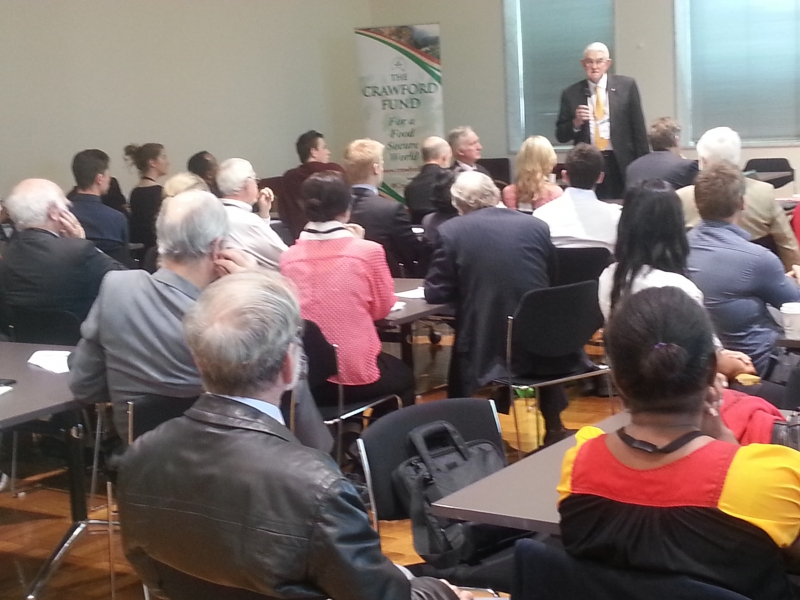

Keynote listeners report highlights from the 2017 Crawford Fund Annual Conference
August 22, 2017
RAID Keynote Listeners Report by Dr David McGill, Ms Miriam McCormack & Dr Madaline Healey
The digital revolution has dramatically impacted our daily life, with change occurring at an increasingly rapid pace in the agricultural sector. The collection, collation, analysis and application of data digitally, has transformed global agriculture through precision technology, forecast modelling and sounder decision making along the supply chain – from demand driven plant breeding, food processing to the delivery of products.
Images courtesy Andrew Tatnell.
This year’s Crawford Conference considered what impact the digital revolution could, and or would, have on the developing world? Could access to better interpretation of data and information herald improvement in agricultural productivity and profitability in these countries and Australia? The simple answer is yes. However, there is still a long way to go in revolutionising agriculture technology for the smallholder farmer and digital mechanisms alone is simply not enough. We need to take a farm, systems and a global approach. However, as stated by Dr Lindiwe Majele Sibanda in her Sir John Crawford Memorial Address, to make digital mechanisms sustainable, to make them useable and ensure they impact we need a new narrative. We need a new narrative for hunger, to set the tone for not just producing more food from less, but producing more nutritionally sensitive food – quality over quantity. Current agricultural systems are not nutrition sensitive, for instance we have 800 million hungry vs 1.8 billion obese or sick. We need to deliver nutrition sensitive agriculture using our global data resources.
Conference overview
The Honourable Barnaby Joyce set the tone for the conference in his opening address ‘Australia has an incredibly honourable role to play in global food security through agriculture.’ During this one-day conference, which has been heralded as Australia’s most significant international food security conference, this was evident. We heard from a range of disciplines and stakeholders, sharing their knowledge, research and reason on the application of digital technology. One of the key themes of the conference was ensuring data is findable, accessible, easy to understand and critically, allows us to make more informed farming choices. One of the challenges we face in use of global data is incomplete information, which sparked conversation around how can we obtain more robust data from growers. Born out of these discussions was the view that that whilst we are all rising to the challenge of nutritional food security and digitalisation as a mechanism, there needs to be institutional change by government and policy to get us there. However, as stated by Dr Lindiwe Majele Sibanda, first and foremost, we need to attract youth and a new generation of agriculturalists and bring in the technology that is required to ensure we can meet the demands of a food and a nutritionally secure world.
How can big data transform small-holder farmers’ lives and livelihoods?
Dr André Laperrière, in his morning keynote address, provided an overview on where the data revolution currently sits with particular reference to farmers in developing countries and with food and nutrition security. He asked, ‘how can data be used to forecast where agriculture is going, and could go, in terms of both feeding the growing world’s population and helping farmers climb out of poverty?’ The answer, by packaging and delivering technology in a manner that informs and translates knowledge to farmers. Data is knowledge and empowerment. We need to make data – environmental, agricultural, climatic and demographics – findable, accessible and easy to understand, and work with smallholder farmers to make use of it to make better and more informed farming decisions. Too much of the worlds data is inaccessible, poorly recorded and very messy, concluding that we need to make data open and available and ensure it is used to solve real world problems.
Uses and challenges of big data for agricultural development
Speakers across the conference agreed that there is a need for guiding principles for ethical collection, ownership and use of data. However, the topic of open sources or commercialisation of data was open to debate. Steve Mathews touched on this when discussing the fact that there is no common language that industry uses to record data information. This makes it hard to understand and hard to implement on farm in a useable format. Robust data in the right format can be developed into global solutions to provide tools for smallholders to make better decisions and more informed choices. However, currently agriculture is the least digitalised industrial sector (McKinsey Global Institute Digitisation Index) and whilst it stands to reap the most critical gains from big data, we are constrained in the large gaps in our data sets. The free market has a role to play in collating bigger and more robust data by incentivising data procurement as a tradable commodity. Steve Mathews highlighted a need to move away from a reliance on government policy and process to shape these changes and look to commercialisation. Paying for data, rather than free sharing, makes it a tradable commodity and therefore more likely to get people to invest their data. Ask for something of value, and people should get something of value in return. A commercial model is therefore far more sustainable, in terms of producing, managing and maintain high-quality data for profitability.
Dr Mario Herrero supported these sentiments, emphasising that it is important to understand smallholder systems and transitions in agriculture, and currently researchers are trying to fill some of the gaps, likening it to a ‘black art’, where the data is incomplete, old or unavailable. We need to continue to gather transdisciplinary data – economics, biodiversity, farm size and nutritional output – to compare farms across systems, globally. We are now at a point with technology that we can use this information to create time-series data for real analysis of development impact, creating a global integrated assessment to move forward in using technology to create a more food and nutrition secure world. He referred to Dr Lindiwe Majele Sibanda’s comments, that ‘we need a more integrated farm and global approach for food security, using nutrition as a driver for shaping supply response in agriculture.’ Mario shared Steve’s sentiment that we need to fill this knowledge gap, but he takes a more open and collaborative approach, sharing the data, keeping it open source rather than a commodity value solution. Data is valuable, and his approach is to collaborate and share data through goodwill, with open source data a better solution.
In his case study presentation Dr Ken Street’s focus was developing rational methods for efficient data mining of our genebanks to improve plant breeding through Focused Identification of Germplasm Strategy (FIGS). He stressed that science does not have to be complicated, it can be very simple, and we need to look for these more targeted and efficient solutions, particularly as we are limited in our resources, time and funding. Using the example of plant breeding, we need to become more effective at evaluating our enormous genetic resources to identify small subsets of germplasm that have a high probability that they will contain the plant traits we need to deliver on ground solutions. We need to marry the simple and the super-sophisticated technologies to offer the opportunity for better crops for farmers and consumers the world over.
ICT adding value for smallholders
In his overview presentation, Dr David Bergvinson echoing the views of other speakers, proposed that we need to attract young energetic people into extension and market integration, and part of this is harnessing the benefits of ICT in communication, which is crucial in science. He indicated that agriculture touches on all 17 of the SDGs in one shape or form and that there are many dimensions to ICT for development to benefit smallholder farmers. The importance of communicating science to farmers, community and policy makers is in attracting the next wave of agriculturalists and farmers, but that we must also engage with farmers, peers, community and researchers to gauge problems and take steps to develop solutions built on these narratives. Stuart Higgins followed on with this narrative in his case study, stating that, ‘if you want to solve agricultural, environmental and health problems, engage a farmer’, start a dialogue, engage and communicate. He spoke about how digital innovations such as CommCare, are taking this principal in the other direction by providing a chance to pay the farmer back, with knowledge, in real-time; potentially providing inspiration to implement change.
The second case study presented by Dr Andrew Mude also stressed the importance of partnerships between commercial sector and farmers for smallholder success, with interaction and communication key to this strategy. He stated that ‘we have been running a large program with one of the companies providing insurance to smallholder livestock farmers.’ A key part of this is having agents understanding the products. Once off training doesn’t work, field staff need on-going interaction to keep updated and continue to develop their skills, it is about continuing this dialogue and continuity in training to ensure a sustainable and effective uptake of technology and solutions on the ground.
Transformational change based on innovation platforms
Dr Mike Briers postulated that we need to use scientific data for impact and as evidence, and borrow from other industries and disciplines to rethink and repurpose innovation platforms. In discussing digital agriculture and robotics, he stressed that we need to make agriculture a knowledge intensive industry and bridge the divide between agriculture and technology. This is a of critical importance with agriculture lagging in terms of digitisation and the need to attract the next generation of farmers and agriculturalist, and agricultural digitisations and innovation could play a critical role in filling these roles. Professor Salah Sukkarieh followed on from this when discussing the equation:
aging workforce + children leaving agriculture = labour shortages in many countries
He put forward the notion that building agricultural robotics can engage youth and teachers, and prepare the next generation of farmers. The robotics being developed in his laboratory represent a futuristic leap towards digitisation of agriculture and livelihoods. Robotic tractors have the potential to reduce on farm labour and improve efficiency of input use. If a prototype can be developed at an affordable price, some smallholders may soon be working plots with a remote.
Concluding this session, Dr Pham Thi Sen presented an example of innovative platforms delivering data aided decision making for vegetable farmers in Vietnam. Using QR codes consumers can trace their food back to a cooperative of farmers working to reduce their inputs to improve safety and sustainability. The consumer is ready to pay a higher premium price for their produce in Vietnam, and diversifying the platform, in which origin of food is transparent and local, delivers another digital aided strategy to engage with consumers and further sustain innovation of smallholder grower market strategies.
How to digitalise agricultural systems in the developing world
Robust data that is accessible and useable; agricultural systems tailored to nutrition security and communication; extension and engagement with farmers, community and industry; developing digital technologies for sustainable smallholder development. These are some of the key themes interwoven throughout the proceedings of the conference, and Dr Andy Jarvis tied them all together in his afternoon keynote address. Actionable personalised information is what we need. Extension adapted to situation and location of these farmers are the way to go, but it’s not as simple as knowing the right information. Trust is important and its part of the equation which will help build the critical relationships needed to pass on complex information and help farmers adapt to their changing system.
Andy reiterated what many speakers had indicated, that agricultural data needs to be findable, accessible, inter-operable and useable and we need young entrepreneurs to unlock the power of big data to support farmers. There is a growing need to develop appropriate technology for smallholder systems, particularly as modern precision agriculture and robotics may not be suitable for the 70% of 500 million farms with less than 1 ha. With 6 billion people owning mobile phones, this is the game changer for data collection and information dissemination and agricultural digitisation, but data still needs a human interface to be truly useful. Concluding that we need to get more systematic about valuing data as a public good, as something which will drive innovation forward in agricultural systems.
Final thoughts
After the conference, it is time for us all to take stock and ask, ‘what is needed to overcome impediments to successful use of big data for transforming agricultural systems?’ We need a worldwide contemporary agenda of the convergence of agriculture, health and environment, to digitalise agriculture and develop efficient and useable technologies and we need to be working towards this together. We need a new narrative to bring agriculture, food and nutritional security into the digital landscape. As Dr Lindiwe Majele Sibanda said ‘we need a new narrative on nutrition sensitive agriculture, we need to go the last mile into the households, as it is the most important place to go to understand the food systems better. We need to bring dignity back to the business of farming, attract a new generation of agriculturalists, and bring the required technologies along with them to deliver nutritional food security globally.





